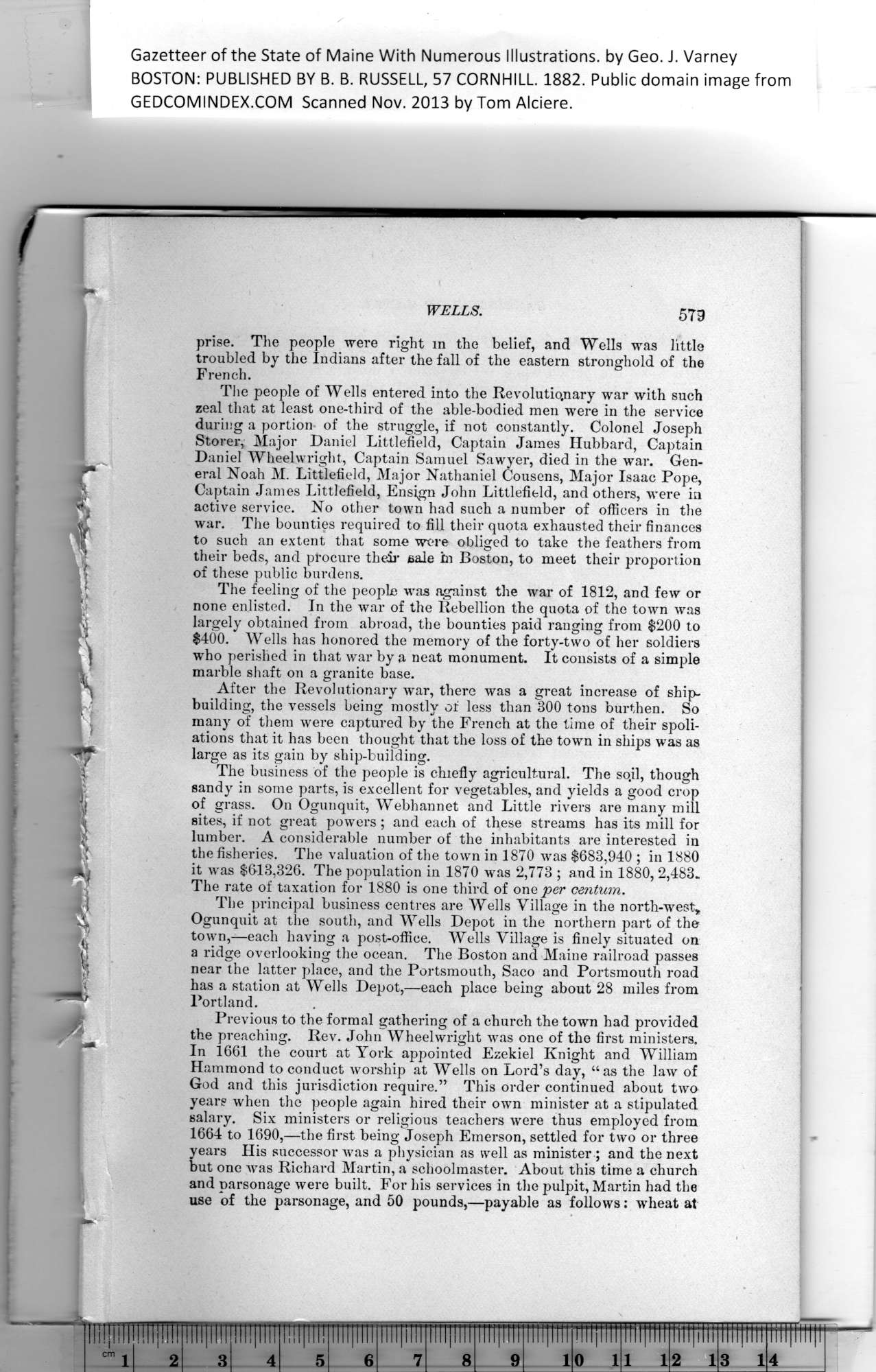|
Gazetteer of the State of Maine With Numerous Illustrations, by Geo. J. Varney
BOSTON: PUBLISHED BY B. B. RUSSELL, 57 CORNHILL. 1882. Public domain image from
WELLS. 57g
prise. The people were right in the belief, and Wells was little
troubled by the Indians after the fall of the eastern stronghold of the
French.
The people of Wells entered into the Revolutionary war with such
zeal that at least one-third of the able-bodied men were in the service
during a portion of the struggle, if not constantly. Colonel Joseph
Storer, Major Daniel Littlefield, Captain James Hubbard, Captain
Daniel Wheelwright, Captain Samuel Sawyer, died in the war. Gen-
eral Noah M. Littlefield, Major Nathaniel Cousens, Major Isaac Pope,
Captain James Littlefield, Ensign John Littlefield, and others, were in
active service. No other town had such a number of officers in the
war. The bounties required to fill their quota exhausted their finances
to such an extent that some were obliged to take the feathers from
their beds, and procure their sale hi Boston, to meet their proportion
of these public burdens.
The feeling of the people was against the war of 1812, and few or
none enlisted. In the war of the Rebellion the quota of the town was
largely obtained from abroad, the bounties paid ranging from $200 to
$400. Wells has honored the memory of the forty-two of her soldiers
who perished in that war by a neat monument. It consists of a simple
marble shaft on a granite base.
After the Revolutionary war, there was a great increase of ship-
building, the vessels being mostly of less than 300 tons burthen. So
many of them were captured by the French at the time of their spoli-
ations that it has been thought that the loss of tbe town in ships was as
large as its gain by ship-building.
The business of the people is chiefly agricultural. The so.il, though
sandy in some parts, is excellent for vegetables, and yields a good crop
of grass. On Ogunquit, Webhannet and Little rivers are many mill
sites, if not great powers ; and each of these streams has its mill for
lumber. A considerable number of the inhabitants are interested in
the fisheries. The valuation of the town in 1870 was $683,940 ; in 1880
it was $613,326. The population in 1870 was 2,773 ; and in 1880, 2,483.
The rate of taxation for 1880 is one third of one per centum.
The principal business centres are Wells Village in the north-west,
Ogunquit at the south, and Wells Depot in the northern part of the
town,—each having a post-office. Wells Village is finely situated on
a ridge overlooking the ocean. The Boston and Maine railroad passes
near the latter place, and the Portsmouth, Saco and Portsmouth road
has a station at Wells Depot,—each place being about 28 miles from
Portland.
Previous to the formal gathering of a church the town had provided
the preaching. Rev. John Wheelwright was one of the first ministers.
In 1661 the court at York appointed Ezekiel Knight and William
Hammond to conduct worship at Wells on Lord’s day, “as the law of
God and this jurisdiction require.” This order continued about two
years when the people again hired their own minister at a stipulated
salary. Six ministers or religious teachers were thus employed from
1664 to 1690,—the first being Joseph Emerson, settled for two or three
years His successor was a physician as well as minister ; and the next
but one Avas Richard Martin, a schoolmaster. About this time a church
and parsonage were built. For his services in the pulpit, Martin had the
use of the parsonage, and 50 pounds,—payable as follows: wheat at
PREVIOUS PAGE ... NEXT PAGE
This page was written in HTML using a program written in Python 3.2
|
